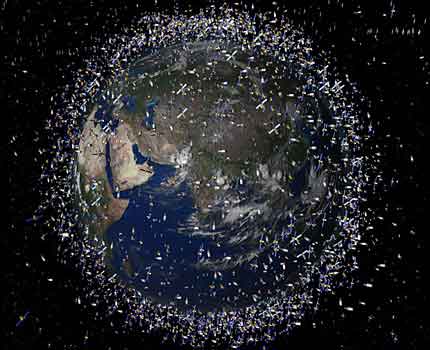 |
|
File photo of the debris orbiting the Earth. The amount of debris orbiting the Earth has reached "a tipping point" for collisions, according to a study. (Agencies) |
|
The amount of debris orbiting the Earth has reached "a tipping point" for collisions, which would in turn generate more of the debris that threatens astronauts and satellites, according to a US study released on Thursday. NASA needs a new strategic plan for mitigating the hazards posed by spent rocket bodies, discarded satellites and thousands of other pieces of junk flying around the planet at speeds of 17,500 miles (28,164 kilomtres) per hour, the National Research Council said in the study. The council is one of the private, nonprofit US national academies that provide expert advice on scientific problems. Orbital debris poses a threat to the approximately 1,000 operational commercial, military and civilian satellites orbiting the Earth -- part of a global industry that generated $168 billion in revenues last year, Satellite Industry Association figures show. The world's first space smashup occurred in 2009 when a working Iridium communications satellite and a non-operational Russian satellite collided 490 miles (789 km) over Siberia, generating thousands of new pieces of orbital debris. The amount of orbital debris tracked by the US Space Surveillance Network jumped from 9,949 cataloged objects in December 2006 to 16,094 in July 2011, the National Research Council said. The surveillance network tracks objects approximately 10 centimeters in diameter and larger. Some computer models show the amount of orbital debris "has reached a tipping point, with enough currently in orbit to continually collide and create even more debris, raising the risk of spacecraft failures," the research council said in a statement released Thursday as part its 182-page report. "The current space environment is growing increasingly hazardous to spacecraft and astronauts," Donald Kessler, the former head of NASA's Orbital Debris Program Office who chaired the study team, said in a statement. (Read by Christine Mallari. Christine Mallari is a journalist at the China Daily Website.) (Agencies)
|
据美国上周四发布的一份报告,地球轨道上太空垃圾的数量已经达到“临界点”,有撞击风险,而后可能产生更多碎片,威胁宇航员和人造卫星的安全。 美国全国研究委员会在报告中称,美国宇航局需要制定新的战略计划,以减小火箭残骸、报废卫星、以及数千块其它太空垃圾的危害。这些轨道太空垃圾时速高达1.75万英里(28164公里)。 该委员会是一家私立的非赢利性国家科研机构,致力于为科学难题提供专家建议。 卫星产业协会发布的数据显示,太空垃圾对地球轨道上空的大约一千个运行中的商用、军用、民用卫星构成威胁。全球卫星产业每年收入高达1680亿美元。 全球首例空间撞击发生在2009年,当时正在运转的一个铱通信卫星和一个俄罗斯报废卫星在西伯利亚上空490英里(789公里)处发生撞击,产生了数千个新的太空垃圾。 美国全国研究委员会称,美国空间监测网跟踪并登记在册的太空垃圾数量在2006年12月为9949个,而在2011年7月就上升到了16094个。 该监测网的监测对象是直径10厘米以上的太空垃圾。 美国全国研究委员会在上周四发布的一份声明中指出,根据某些计算机模型,太空垃圾的数量已经“达到临界值,目前在轨的垃圾数量足以发生频繁撞击,并由此产生更多的垃圾碎片,从而增大损毁航天器的风险。”这份报告长达182页。 研究小组负责人唐纳德•凯斯勒在声明中说:“目前的太空环境对飞行器和宇航员来说越来越危险。”凯斯勒曾担任美国宇航局轨道垃圾项目办公室负责人。 相关阅读 (中国日报网英语点津 Julie 编辑:陈丹妮) |
|
Vocabulary: tipping point: 临界点 spent: used up or exhausted; consumed(用过的,失去效能的) smashup: a serious collision between vehicles; a wreck(猛撞,粉碎) |
